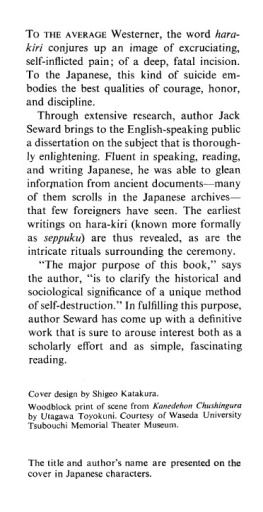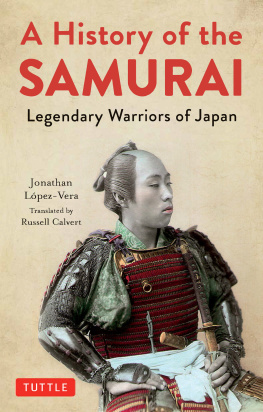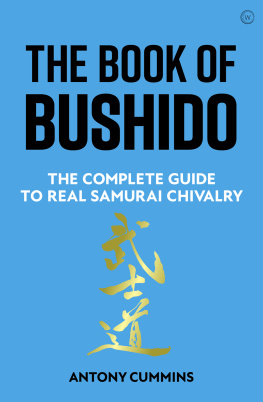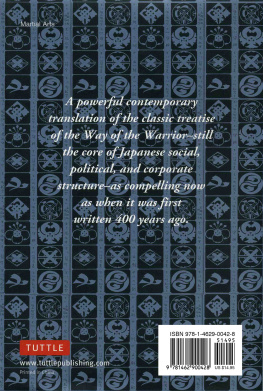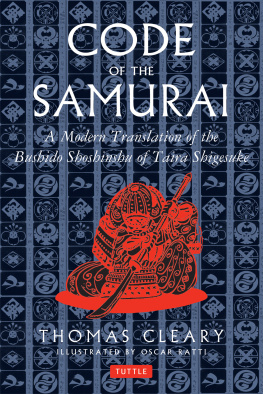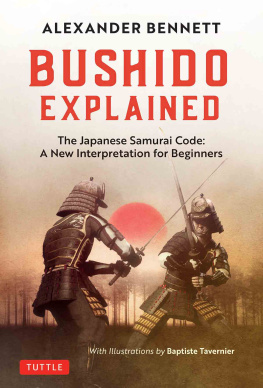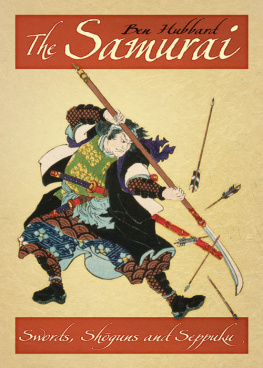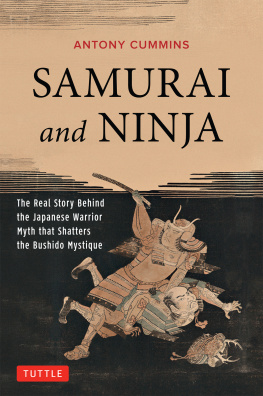BIBLIOGRAPHY
FUJITA, TOKO: Kodokan Kijutsu Gi (The Significance of the Kodokan Narrative). A scroll believed to have been written in the 19th century, currently in Ueno Library, Tokyo.
HOJO, CHIKUHO: Shido Kokoroe Sho (The Book of Knowledge of Bushido). Reproduced in the 6th Volume of the Nihon Kokusui Zensho (Japan National Purity Collection). 1929.
ISHIDA, BUNSHIRO: Nippon Bushido-shi no Taikeiteki Kenkyu (Systematic Research into the History of Japanese Bushido). Kinseisha, Tokyo.
KOJIMA: Taiheiki (Chronicles of War). Forty scrolls believed written by a bonze named Kojima who began this work in 1368.
KUDO, YUKIHIRO: Jijinroku (Notes on Self-Destruction). 1840.
MATSUOKA, YUKIYOSHI : Teijo Zakki (Miscellaneous Notes of Teijo). Unpublished manuscript in 16 scrolls, currently in Ueno Library, Tokyo.
MURDOCH, JAMES: A History of Japan. Three volumes. Routledge & Kegan Paul, Ltd., London, 1949.
NITOBE, INAZO: Bushido, The Soul of Japan. Shokwabo, Tokyo, 1900.
OGINO, YOSHIYUKI: Nippon Seido Tsu (Commentary on Japanese Institutions). Yoshikawa Kobunkan, Tokyo, 1926.
LORD REDESDALE: Tales of Old Japan. Reprint edition. Charles E. Tuttle Co., Inc., Tokyo, 1966.
SHIOYA, SAKAE: Chushingura, An Exposition. Kenkyusha, Tokyo, 1940.
TOKINAGA, HAMURO: Hogen Monogatari (Tales of Hogen). Three scrolls written between 1185 and 1190.
TOKUGAWA, IEYASU : Goyuijo Hyakkajo (The One Hundred Articles of Testimony). Sakuhinsha, Tokyo, 1962.
WADA, KATSUNORI: Seppuku Tetsugaku (Philosophy of Seppuku). Shubunsha, Tokyo, 1927.
YAMAMOTO, TSUNETOMO: Hagakure (In the Shade of the Leaves). Keiei Shicho Kenkyukai, Tokyo, 1964.
YAMANO, SHOTARO: Nippon Jisatsu Joshiki (Notes on Suicide in Japan). Kobunsha, Tokyo, 1938.
YAMAOKA, SHUMMEI: Seppuku Jisatsu Kojitsu no Koto (Old Facts about Seppuku and Suicide).
I
SEPPUKU DEFINED
Definition
SEPPUKU is the keynote of discipline in the Japanese code of chivalry. To define it precisely, we should first know why there are two widely used words with the same meaning: seppuku and hara-kiri.
In Japanese society today, the accepted rule is to render official terms in the on or Japanese way of pronouncing the original Chinese character, and such is the case with seppuku. The same two characters, in reverse order, can also be read hara-kiri in the kun or native Japanese style of pronunciation. The word hara-kiri is used only in conversation, and not for official purposes or in formal speech or writing.
Hara-kiri is mentioned in numerous books written by Westerners. The Encyclopedia Britannica, Nelson's Encyclopedia, and Webster's New International Dictionary carry the word. For example, the last gives:
hara-kiri (ha'ra-k'r) n. (Jap., stomach cutting). Suicide by the nobles and samurai in case of disgrace, real or fancied, and commanded by the government to certain disgraced officials; disembowelment; more elegantly called seppuku. Written also, but incorrectly, hara-kari.
Many Westerners know this much about the word, but their knowledge about the full and deeper significance of the practice itself is limited. To provide a practical initial introduction, it is pertinent to refer to an account of seppuku written by an Englishman, Lord Redesdale (the former A. B. Mitford), who was Secretary to the British Consulate in Japan in 1868, the first year of the modern era in Japan.
First Eyewitness Account by a Westerner
Through the last years of the Tokugawa Era and into the initial years of that of Meiji, there was much internal strife in Japan between the supporters of the Emperor and the adherents of the Shogun (the de facto administrator of the country), especially over the burning question of foreign inroads. During this period of confusion, several incidents hostile to Westerners occurred.
In February of 1868, a number of Japanese soldiers from Bizen fired on the foreign settlement in Kobe, which was then called Hiogo. The responsible Bizen samurai was ordered to commit seppuku. Lord Redesdale was one of the witnesses to the ceremony, and recorded it in his book, Tales of Old Japan. An excerpt runs as follows:
As a corollary to the above elaborate statement of the ceremonies proper to be observed at the hara-kiri, I may here describe an instance of such an execution which I was sent officially to witness. The condemned man was Taki-Zenzaburd, an officer of the Prince of Bizen, who gave the order to fire upon the foreign settlement at Hiogo in the month of February, 1868an attack to which I have alluded in the preamble to the story of the Eta Maiden and the Hatamoto. Up to this time, no foreigner had witnessed such an execution, which was rather looked upon as traveller's fable.
The ceremony, which was ordered by the Mikado himself, took place at 10: 30 at night in the temple of the Seifukuji, the headquarters of the Satsuma troops at Hiogo. A witness went from each of the foreign legations. We were seven foreigners in all.
We were conducted to the temple by officers of the Princes of Satsuma and Choshiu. Although the ceremony was to be conducted in the most private manner, the casual remarks which were overheard in the streets, and a crowd lining the principal entrance to the temple, showed that it was a matter of no little interest to the public. The courtyard of the temple presented a most picturesque sight; it was crowded with soldiers standing around in knots round large fires, which threw a dim flickering light over the heavy caves and quaint gable-ends of the sacred buildings. We were shown into an inner room, where we were to wait until the preparation for the ceremony was completed: in the room next to us were the high Japanese officers. After a long interval, which seemed doubly long from the silence which prevailed, Ito-Shunske, the provisional Governor of Hiogo, came and took down our names, and informed us that seven kenshi, sheriffs or witnesses, would attend on the part of the Japanese. [Kenshi means inspector of the corpse.] He and another officer represented the Mikado; two captains of Satsuma's infantry, and two of Choshiu's, with a representative of the Prince of Bizen, the clan of the condemned man, completed the number, which was probably arranged in order to tally with that of the foreigners. Ito-Shunske further inquired whether we wished to put any questions to the prisoner. We replied in the negative.
A further delay ensued, after which we were invited to follow the Japanese witnesses into the hondo or main hall of the temple, where the ceremony was to be performed. It was an imposing scene. A large hall with a high roof supported by dark pillars of wood. From the ceiling hung a profusion of those huge gilt lamps and ornaments peculiar to Buddhist temples. In front of the high altar, where the floor, covered with beautiful white mats, is raised some three or four inches above the ground, was laid a rug of scarlet felt. Tall candles placed at regular intervals gave out a dim mysterious light, just sufficient to let all the proceedings be seen. The seven Japanese took their places on the left of the raised floor, the seven foreigners on the right. No other person was present.
After an interval of a few minutes of anxious suspense, Taki-Zenzabur, a stalwart man, thirty-two years of age, with a noble air, walked into the hall attired in his dress of ceremony, with the peculiar hempen-cloth wings which are worn on great occasions. He was accompanied by a kaishaku and three officers, who wore the jimbaori or war surcoat with gold-tissue facings. The word kaishaku, it should be observed, is the word to which our word executioner is no equivalent term. The office is that of a gentleman; in many cases it is performed by a kinsman or friend of the condemned, and the relation between them is rather that of principal and second than that of victim and executioner. In this instance the kaishaku was a pupil of Taki-Zenzabur, and was selected by the friends of the latter from among their own number for his skill in swordsmanship.

